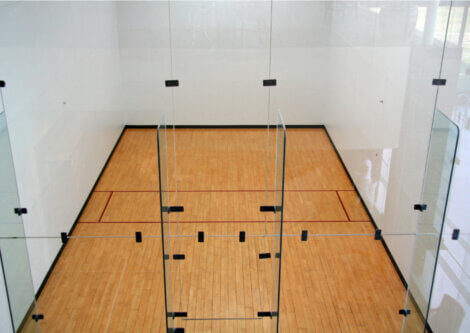What is Wallyball?

If you combine parts of one sport with others, you can come up with new games that can be even more fun, or at least simpler to practice. That’s the case with wallyball, which combines certain aspects of volleyball, paddle tennis, and racquetball.
You might be wondering if it’s a sport that’s played with rackets, thanks to the above-mentioned sports. But no! Actually, wallyball has borrowed the walls from these sports, that mark out the boundaries of the court. And it doesn’t just incorporate the walls as part of the court, they’re also part of the game strategy!
Getting to know wallyball
Now then, where does this unique (and in some places little known) game come from? It’s said that it all started in 1979, in the city of Calabasas, in the state of California. Joe Garcia was its creator.
As is the case of many other indoor sports, wallyball started out as an alternative sport to play during the long winter months. During that time of year, the weather makes outdoor sports somewhat difficult. Since then, wallyball has become very popular in the United States and has even boosted the use of racquetball courts, which were on a decline in popularity.
The term ‘wallyball’ is a combination of two words: wall, and volleyball, the main inspiration for this game. Pretty simple, right?
Wallyball game rules
As we mentioned above, the most outstanding feature of wallyball is that you can use the walls that make up the boundaries of the playing court. However, there are also some other peculiarities that are worth pointing out. We’ll discuss these below!
Number of participants
Thanks to the smaller playing space, about half of the normal amount of players for volleyball make up a team. In wallyball, you can have teams of around three players.

Point system
This is perhaps the most complicated part of wallyball. Two different scoring methods can be used. The first, rally scoring, is where one point on every serve is scored up until one team reaches freeze point, which means that three more points are needed before a set is finalized.
Once a freeze point is reached, only the team that serves can score points. If the team that doesn’t have the serve earns a point, they can get the serve back and then add the point. This is a scoring system that was used in professional volleyball until the year 2000.
On the other hand, an alternative scoring system is using the point system from volleyball, where each team that wins a round earns a point and then earns the right to serve the next round.
Playing court dimensions
To play wallyball, you can use a racquetball court, which measures 40 feet long, 20 feet wide, and 20 feet high. A net divides the court in half, that should be three feet tall and the top shouldn’t be higher than eight feet tall. For women’s games, the top of the net should be at seven feet, six inches high.
The ball
In this aspect, wallyball is the same as volleyball; they use the same ball. It’s rubber and is 25 to 27 inches in circumference. It must weigh between nine and ten ounces.
What about the hits? In this twist on volleyball (its players consider it a separate sport) Rotation on handsets is watched closely and receiving the ball must be done cleanly. Ball handling is stricter in wallyball than in volleyball.
Use of the walls
During the serve, the ball can hit one of the walls (only one) on either side of the net. This means that the ball can go to the opposing team’s side after hitting one of the walls on the serving team’s side. It must not hit the ceiling.

When the team members are passing the ball between each other during the volley, the ball can hit any of the walls on their side or the ceiling. However, when passing the ball to the other side, it must comply with the one rule, not the ceiling rule that we mentioned above for the serve.
Wallyball, a sport for inventing and having fun
The rules above are the official rules that apply to this sport. However, thanks to the chaotic fun it can create, many choose to eliminate, add, or even invent their own rules for their games.
Of course, as long as the modifications keep with the idea of a dynamic and entertaining sport, they’re very welcome. You can even alter the dimensions of the court if you don’t have a racquetball court to play on. Do you want to give this innovative sport a try?
If you combine parts of one sport with others, you can come up with new games that can be even more fun, or at least simpler to practice. That’s the case with wallyball, which combines certain aspects of volleyball, paddle tennis, and racquetball.
You might be wondering if it’s a sport that’s played with rackets, thanks to the above-mentioned sports. But no! Actually, wallyball has borrowed the walls from these sports, that mark out the boundaries of the court. And it doesn’t just incorporate the walls as part of the court, they’re also part of the game strategy!
Getting to know wallyball
Now then, where does this unique (and in some places little known) game come from? It’s said that it all started in 1979, in the city of Calabasas, in the state of California. Joe Garcia was its creator.
As is the case of many other indoor sports, wallyball started out as an alternative sport to play during the long winter months. During that time of year, the weather makes outdoor sports somewhat difficult. Since then, wallyball has become very popular in the United States and has even boosted the use of racquetball courts, which were on a decline in popularity.
The term ‘wallyball’ is a combination of two words: wall, and volleyball, the main inspiration for this game. Pretty simple, right?
Wallyball game rules
As we mentioned above, the most outstanding feature of wallyball is that you can use the walls that make up the boundaries of the playing court. However, there are also some other peculiarities that are worth pointing out. We’ll discuss these below!
Number of participants
Thanks to the smaller playing space, about half of the normal amount of players for volleyball make up a team. In wallyball, you can have teams of around three players.

Point system
This is perhaps the most complicated part of wallyball. Two different scoring methods can be used. The first, rally scoring, is where one point on every serve is scored up until one team reaches freeze point, which means that three more points are needed before a set is finalized.
Once a freeze point is reached, only the team that serves can score points. If the team that doesn’t have the serve earns a point, they can get the serve back and then add the point. This is a scoring system that was used in professional volleyball until the year 2000.
On the other hand, an alternative scoring system is using the point system from volleyball, where each team that wins a round earns a point and then earns the right to serve the next round.
Playing court dimensions
To play wallyball, you can use a racquetball court, which measures 40 feet long, 20 feet wide, and 20 feet high. A net divides the court in half, that should be three feet tall and the top shouldn’t be higher than eight feet tall. For women’s games, the top of the net should be at seven feet, six inches high.
The ball
In this aspect, wallyball is the same as volleyball; they use the same ball. It’s rubber and is 25 to 27 inches in circumference. It must weigh between nine and ten ounces.
What about the hits? In this twist on volleyball (its players consider it a separate sport) Rotation on handsets is watched closely and receiving the ball must be done cleanly. Ball handling is stricter in wallyball than in volleyball.
Use of the walls
During the serve, the ball can hit one of the walls (only one) on either side of the net. This means that the ball can go to the opposing team’s side after hitting one of the walls on the serving team’s side. It must not hit the ceiling.

When the team members are passing the ball between each other during the volley, the ball can hit any of the walls on their side or the ceiling. However, when passing the ball to the other side, it must comply with the one rule, not the ceiling rule that we mentioned above for the serve.
Wallyball, a sport for inventing and having fun
The rules above are the official rules that apply to this sport. However, thanks to the chaotic fun it can create, many choose to eliminate, add, or even invent their own rules for their games.
Of course, as long as the modifications keep with the idea of a dynamic and entertaining sport, they’re very welcome. You can even alter the dimensions of the court if you don’t have a racquetball court to play on. Do you want to give this innovative sport a try?
All cited sources were thoroughly reviewed by our team to ensure their quality, reliability, currency, and validity. The bibliography of this article was considered reliable and of academic or scientific accuracy.
- Reglas oficiales de vóleibol. Federación Internacional de Vóleibol. http://www.fivb.org/EN/Refereeing-Rules/documents/FIVB-Volleyball_Rules_2017-2020-SP-v01.pdf
- USA Racquetball’s Official Rulebook. USA Racquetball. https://www.teamusa.org/usa-racquetball/rules
- THE SPORT OF WALLYBALL. WALLYBALL HISTORY HOW TO PLAY. College Sports Scholarships. https://www.collegesportsscholarships.com/history-wallyball.htm#:~:text=Wallyball%2C%20also%20known%20as%20rebound,winter%20weather%20drives%20people%20indoors.
This text is provided for informational purposes only and does not replace consultation with a professional. If in doubt, consult your specialist.








